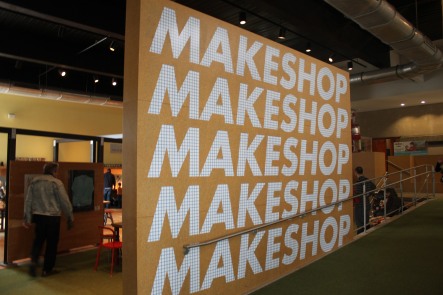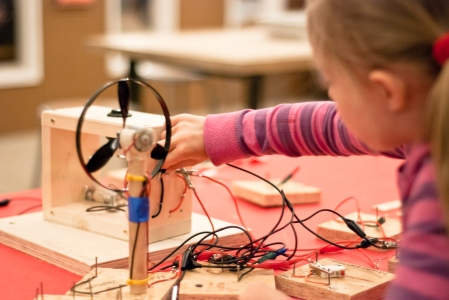 I recently caught up with Lisa Brahms, the Director of Learning and Research at Children’s Museum of Pittsburgh, to ask her about the development of their innovative MAKESHOP. Lisa has been an educator and designer of formal and informal learning experiences and environments for over a decade, working in schools and at numerous children’s, art and history museums, and is currently pursuing her Ph.D. in Learning Sciences and Policy at the University of Pittsburgh (where she is a member of the University of Pittsburgh Center for Learning in Out of School Environments – UPCLOSE). We talked about the challenge of creating a maker space for children and what it was like to bring “maker”-style activities, both analog and digital, into their museum.
I recently caught up with Lisa Brahms, the Director of Learning and Research at Children’s Museum of Pittsburgh, to ask her about the development of their innovative MAKESHOP. Lisa has been an educator and designer of formal and informal learning experiences and environments for over a decade, working in schools and at numerous children’s, art and history museums, and is currently pursuing her Ph.D. in Learning Sciences and Policy at the University of Pittsburgh (where she is a member of the University of Pittsburgh Center for Learning in Out of School Environments – UPCLOSE). We talked about the challenge of creating a maker space for children and what it was like to bring “maker”-style activities, both analog and digital, into their museum.
Lisa, please share with us about where you work.
The Children’s Museum of Pittsburgh is one of the leading children’s museums in the country. Our MAKESHOP is really among the first official maker spaces, you know, dedicated to providing family audiences with opportunities to make at the intersection of the digital and the physical in children’s museums.

What makes a space a maker space?
I think the intention behind it makes a maker space. Our space came about at a time when the Maker Movement’s orientation towards the educational landscape was really gaining momentum. It just was very good timing. This is two and a half years ago, when we really started thinking about it. And, yeah, it was just an aligning of… of… I think, the stars.
Our design philosophy at the museum is to “play with real stuff,” which initially was all about physical materials and processes. We have a space in the museum called the Studio which is about working with real materials and real processes of fine art. So things like real clay, real print making, real paper making, real painting. And that was a very popular space and we felt very proud of that space. So we thought, why not take it one step further. How do we create a space for kids who might be a little bit older, where kids can dig a little deeper. Our museum is full of makers and crafters, artists – that’s who run the place. So DIY crafts like sewing, woodworking, electronics, bumping up against what was the potential for digital media in our space, we never had done that before, really, in a concerted way.
And so, yeah, we just started.
Please describe your process creating something new like this. What materials and partners did you need to pull it off?
The idea for MAKESHOP actually came out of a meeting that was of the Kids and Creativity Network, which is a network in Pittsburgh that’s really amazing and unique. Pittsburgh is a small city with a lot of people and money dedicated to great things for kids. At one of those meetings, Jane, our director, was sitting next to Drew Davidson of the ETC and Jesse Schell was there of Schell Games and everybody was throwing out ideas. Jesse had this idea for a place where kids can make things, and they were like, “That’s a great idea! Let’s do it!”
Then other stars were aligning and so we decided to do what we always do and prototype the idea. At our museum, we make everything in-house — all exhibits, all programs — and we prototype everything we do and we never really call it done. We’re always tweaking, we’re always changing. And this was no exception. So for about eight months we prototyped MAKESHOP in a very small space with a very, very small staff. There were really like only one whole person and two half-people that spent a summer along with three ETC interns. We did it by medium — we started with electronics — and we thought: What would it be like to approach electronics with young children and families? Then we did sewing: What would it be like to sew with a sewing machine with a three-year-old? And then we did it with woodworking: What does it mean to do woodworking with real tools, real materials, real processes, open-ended, with three to five-year-olds?
And so, we learned so much. We tweaked what we did every single day. We thought a lot about scaffolding. And we thought a lot about space design, activity design, of course…
Well, let me ask…you described a lot, you tested through the activities but you were not designing programs. You were designing a space.
Yup.
At some point, you guys have to build a space — you have to do air conditioners and wires. So at what point did you decide you had iterated enough of the program to know what the space needed to look like? Because it’s hard to iterate a physical space.
Yeah. And our space is still changing. I mean, when we started designing the space it was a very quick development because, very quickly in the process, we realized that the space itself mattered less than the people that we had to help facilitate the space, and the materials that we were able to bring into the space. I don’t remember when it was, but it was like a month of design which is unheard of, kind of.
Is that short or long?
Short! Yeah, for exhibit development, for the design of the actual structure of the space. So, we took everything we learned and we worked with our in-house developers and designers and ordered all the materials and, by October of 2011, we opened.
But we had never done sewing and woodworking and digital media at the same time. We’re still learning and growing every day.

Please say more about beginning to think about working with digital media, which was new. What role does digital media play?
At our museum, the play was real stuff, that always meant non-digital materials, non-digital anything, but, as I said previously, we realized as we were thinking about MAKESHOP that in children’s lives today there’s really very little distinction between the physical and the digital world. So how do you respect that and embrace that while knowing the people that we had on staff, and have on staff, don’t have as much expertise in that area.
One of our key partners is ETC. I didn’t say that at the beginning- the three partners of the MAKESHOP, which are all very central, are the museum, ETC and UPCLOSE, the University of Pittsburgh Center for Learning Out of School Environment, which is the research lab. And that’s how I came into it — as a researcher, not as the project director. Still now, every semester, an ETC group works with our team to design something new for the space. Every semester an ETC project team will develop something for us. The most successful ones have been very focused on an area of making that we feel we don’t do well enough that they can help us do.
For instance?
For instance, we knew that computer programming is just a skill that makers have and that it’s something makers do. And the more you can do that, the more you can make. But how do you introduce computer programming to a three-year-old? It became the best ETC project thus far. The team really took that challenge and ran with it. Of course, there are failures and there are successes with that process. One failed really wonderfully!
So those are the staff who have the skills to work with digital media?
Yeah. And actually our MAKESHOP staff has five dedicated MAKESHOP teaching artists. And so each of them have their own making expertise — all different areas of expertise — but two of them come from the ETC.

What are some key things you’ve learned that have contributed to the successes?
I want to stress how important facilitators are. We really invested in talent and hired people who didn’t necessarily have educational expertise. Some of them, not all of them, had background in working with children and families. But they had the interest and intention. They had great expertise in making as well as interest in wanting to learn more about different mediums in making. We’ve maintained our staff and only grown it since we started.
Another key thing about MAKESHOP that we’ve learned is that when we were prototyping we thought that every kid that came in would make a thing. Like, a product. So we thought the question we would ask each visitor was going to be, “What do you want to make today?” We’ve realized, relatively quickly, that that wasn’t the key question. Things people want to make are one very important entry point but “stuff” like exploration of things, exploration of materials and tools and exploration of processes — like how you sew two pieces of fabric together — are just as important and meaningful entry points as well as outcomes of a learning experience.
This educational landscape in making has really taken root and gained momentum, everybody’s interested in it right now. And so we see it as our responsibility to really try and understand how you introduce and plant the seed for making in very young children and their parents. We really see we have a unique opportunity as a children’s museum to think about the really young ones and think critically about how to do that.
And it’s hard work.
I’m curious if this space has had an impact on the museum overall.
Very much so!
In what way?
The MAKESHOP model has worked so well that we’re thinking about how we can extend that to other areas of the museum. For instance, the Studio. Now we’re thinking about how can we have a Studio staff that can really nurture each other and help the Studio to always be innovating and always be doing new things. The model is working and we’ve become a model for the whole children’s museum community. Which is really cool, you know? And, yeah, it’s a unique position that we’re in. We’re proud and we’re doing all we can to be the best model we can be.
Lastly, one thing that we have seen, and I’m really happy to see, is that the way we’re doing it is not the only way to do it. There are so many other museums presenting making experience very differently and I feel like there’s any number of ways to do this well, just like making, places are innovating on the idea and making it their own.




Pingback: MAKESHOP at Pittsburgh’s Children’s Museum | Moosha Moosha Mooshme